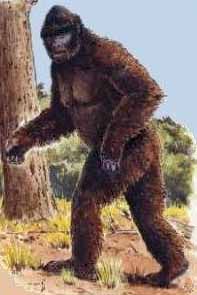Vocaroo Voice Message, This EVP was recorded earlier today and growling can be heard at points, i was talking to my friend who runs a paranormal facebook page, asking him if he wanted to watch a video on YouTube but a faint voice can be heard saying yes, even though i wasn't recording my System Audio https://www.facebook.com/pages/Paranormal-friends/148825421983663?fref=ts
PARANORMAL PLUS
sightings,reviews and more! If you've seen a something strange, or you have video or photographic proof of something send it to us via Ryanday32@gmail.com (mark as important) and the title of email must be paranormal plus:[sighting/evidence]
Translate
Sunday 4 August 2013
Friday 28 June 2013
BREAKING NEWS!
The
African Western Black Rhino has just been declared extinct due too
poaching! The longer i live the longer i see that Homo Sapiens have
become the rock bottom of evolution, i mean no wonder nature has evolved
so much stuff too kill us! i cannot think of one species that's more
destructive than ours! I can safely say I am ashamed too be part of the
Human race!
Widlmen 6: Wildmen of Africa
The Chimiset:
NO IMAGES EXIST!
A mysterious primate which is one of the few exceptions of Ape-like or Human-like classification rule, because its reported to look more like an upright baboon than a Ape or Man.lso known as Chimiset, Chimisit (these, like Chemosit, mean 'devil' in the region's folklore) and Nandi Bear (after a Kenyan tribe). Reports of the creature are numerous, specially in east-central Kenya. It is described as being as large as a man, long reddish to yellow hair, short broad tail, sometimes going on four legs, sometimes on two, and a general appearance of a huge, very fierce baboon. It is said to be as comfortable on the tree tops as it is on the ground, and to attack humans on sight, allegedly being responsible for several killings of men and live stock. According to some tales, it is specially fond of brains.
Other names by which the creature is known, depending on the part of Africa, are Duba (the Swahili and villages along the Tana river), Kerit, Shivuverre (Kakumega country, Kenya), Kikomba (West Africa), Koddoelo (Ngao state, Kenya), Sabrookoo (Kenya/Uganda frontier), Engargiya (Uganda), Gadett (Lumbwa district, Kenya), Ngoloko (Tanzania), Kikambangwe and Ikimizi (Ruanda).
Thursday 27 June 2013
Wildmen 5: Wildmen of Asia, Japan, Vietnam and Sumatra
The Yeti:
 |
| A Yeti type creature walking up a mountain |
The Yeti, depending on the area you are in, ha many names:
Michê (Tibetan: མི་དྲེད་, Wylie: mi dred, ZYPY: Michê) translates as "man-bear".
Dzu-teh – 'dzu' translates as "cattle" and the full meaning translates as "cattle bear", referring to the Himalayan brown bear
Migoi or Mi-go (Tibetan: མི་རྒོད་, Wylie: mi rgod, ZYPY: Migö/Mirgö) translates as "wild man".
Bun Manchi - Nepali for "jungle man" that is used outside Sherpa communities where yeti is the common name.
Mirka – another name for "wild-man". Local legend holds that "anyone who sees one dies or is killed". The latter is taken from a written statement by Frank Smythe's sherpas in 1937.
Kang Admi – "Snow Man".
Descriptions on the Yeti vary mainly in height leading researchers too believe that the larger creatures sighted are more adult creatures, not a separate species.
Mande Barung:
 |
| Artists impression of Mande Barung |
Generally described as a large, hairy bipedal hominid, some believe that this animal, or its close relatives, may be found around the world under different regional names, such as the Yeti of Tibet and Nepal, the Ban-manush in Bangladesh, the Yeren of mainland China, and the Bigfoot of the Pacific northwest region of the United States and the Canadian province of British Columbia.
The Mande Barung is known through out India for its violence towards Humans and in Indian legend and folklore the Mande Barung is regarded as the guardian of the forest.
The Yeren:
 |
| A model of the Yeren |
The creature is said to stand an average of six and a half feet tall and to be covered in thick brown or red hair. It is bi-pedal and has a hefty abdominal region as well as an ape-like muzzle, large ears and eyes like that of a human, leaving behind large footprints, up to sixteen inches long, with five toes, four small toes held close together and a larger toe that points outward slightly.
According to Chinese folklore, the creature eats people. Coming across a human, it grips his or her arms tightly, making escape impossible. It is apparently so overjoyed by trapping its prey that it faints with mirth - but without losing its hold. When it returns to its senses, it kills and eats its victim. Thus travelers in the mountains were advised to wear a pair of hollow bamboo cylinders on their arms. If a Wildman caught them, they could then, while the creature was in swoon, slip their arms out of the cylinders and escape. Reports of the creature go back to as far as 2000 years.
The Almas/Relic Neanderthal:
NO IMAGES EXIST!
The Almas is perhaps the most amazing Man-like wildman ever reported because of the fact their have been many reports of Almas-human interaction and interbreeding! It its mainly reported in Russia, Kazakhstan and Mongolia where it is described as terrified of Homo Sapiens and can take months for one too trust someone enough too come close enough for a close look.Loud noises are said too scare them. They are often reported as fury or hairless wearing ice-age clothing.
Also known as Almasty and Albasty these strange apelike creatures, allegedly resembling Neanderthal man.
In the Caucasus, Almas (which in the Mongolian language means 'wildman') are well known by the local people, who tell numerous stories of an apparent familiarity between humans and these creatures. Eyewitness accounts dating back hundreds of years describe Almas communicating with humans by means of gestures. There were even stories of Almas bartering food for trinkets.
Adult Almases have been described as being at least 5 ft tall, shy, hairy, with prominent eyebrow ridges, a receding chin and a jaw that protrudes out.
Other names by which these creatures are known, depending on the particular region, are 'Wind-Man', Abnuaaya, Bekk-Bok, Biabin-Guli, Gul-Biavan, Guli-Avan, Golub-Yavan, Kaptar, Kra-Dhan, Ksy-Giik or Ksy Gyik, Mirygdy, Mulen and Voita.
The Meh-Teh:
 |
| A Artists impression of the Meh-Teh |
The Meh-Teh ("man-beast") is a possible subspecies of Yeti supposedly proportioned more like a hairy heavy set man (but it leaves a most unhuman type of footprint), and the Dzu-Teh like a gigantic ape-man. Another type of Yeti (pygmy size) is called Teh-lma.
The Meh-Teh is allegedly a very bestial and shy type of hairy hominid, with a animal-like behavior and thick reddish-brown to black fur, a conical head, stout neck, wide mouth with no lips, and long arms which reach almost to its knees, supposedly inhabiting the Tibetan upper plateau forests. Its five-toed feet are short and very broad, with a second toe longer than the big toe.
The Chuchunaa:
| Artists impression of the Chucchunaa |
Chuchunaa is Siberia's Bigfoot. The Chuchunaa were reported by a branch of the Soviet Academy of Science as recently as the 1950s in the bitterly cold and forbidding region of northeast Siberia, who speculated that they might represented the last surviving remnants of paleo-asiatic aborigines that retreated to the upper reaches of the Yana and Indigirka rivers.
These people are said to have an extremely limited range of oral sound. This may have been a genetic mutation - or is it an indication of these people's Neanderthal origin?
The Chuchunaa are described as being very tall with a protruding brow and long matted hair, usually sporting some type of animal skin covering. Locals swear it is a man-eater. Recent reports suggest that they have withdrawn to even more remote areas away from encroaching civilization.
The Higabon:
The Nguoi Rung:
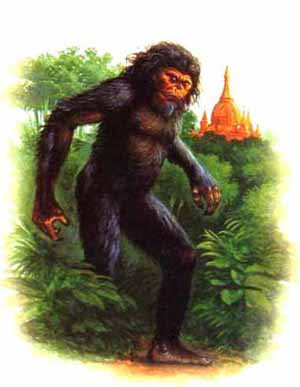 |
| Artists impression of the Nguoi Rung |
The Nguoirung is also known as the Vietnamese Wildman, or "Forest People". Appearance and legends are similar as for the Wildman of China; it is described as being approximately six feet tall and completely covered with hair except for the knees, the soles of the feet, the hands and the face. The hair ranges in color from gray to brown to black. The creature walks on two legs and has been reported seen both solitary and moving in small clans.
Along the Laotian border the beast is called Khi-Trau, meaning "buffalo monkey" or "big monkey".
The Orang Pendek:
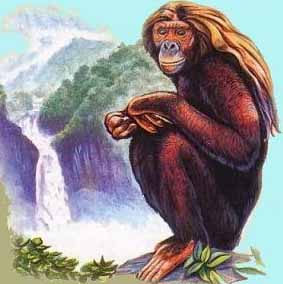 |
| Artists impression of Orang Pendek |
Sumatra's Sasquatch. Other local names include Gugu, Sedapa, Sedabo and Atu. They are said to stand between three and five feet tall (a few reports describe slightly taller specimens), to be covered with short dark hair, with a thick, bushy mane going halfway or farther down the back, and to have a smooth, hairless brown face.
Witnesses frequently mention the Orang-Pendek's startlingly humanlike appearance, thus its name. Sightings have been reported for centuries on Sumatra, but what is considered to be the first modern sighting happened in 1916, described in an article by Dr. Edward Jacobson. He stated that, while camped near the base of Boekit Kaba mountain, some of his scouts sighted the creature. He also claimed to have found some footprints at Mount Kerintji.
Wednesday 26 June 2013
Wildmen 4: The Wildmen of South America.
Mapinguary/Mapinguari:
The Mapinguary is separated into three distinctly different types of sightings. The group of sightings centered around Brazil reports an large (reported too be larger than the American Sasquatch) foul smelling creature covered in red hair and an awful screaming cry (although some eye witnesses describe it as a shriek). It's said to be incredibly violent and has bee known to dismember cattle with its bare hands.
It is responsible for the death of many Brazilians, but it avoids major cities. This has lead researchers too believe that deforestation of the Rainforest has caused it to come into confrontation with modern Humans.
 |
| The Giant-Ground Sloth on the BBC's Walking With Beats TV series. |
It is also described as being incredibly violent but much larger and stronger with a much more Sloth like appearance, it normally seen in deep forests but is occasionally seen in small towns and villages like the Ape-like Mapinguary.
 |
| This version of the Mapinguary is woven into Brazilian mythology. |
The perhaps mos perplexing Mapinguary sightings are that of an one eyed creature with a mouth on its body (this is some times reported as a second mouth though). This creature is reported to have amazing strength like the other two as well as the red fur/hair but is said to be smaller and a strict vegetarian. It's also reported to be much less aggressive than the other two monsters.
Aluxes, Goazis and Guayazis:
 |
| A Mayan model of an Alux |
These elusive creatures are "Dwarf-like man faced"
creatures said to inhabit South America.
creatures said to inhabit South America.
This creatures are incredibly elusive and are taken very seriously by the South American population.
To even suggest these creatures may not exist is extremely offensive too those who live in small villages and towns.
 |
| A possible Alux hut? |
 |
| Artists impression of the Alux |
Aigypans, Salvaje, Achi and Vasitris:
NO IMAGES EXIST
These beings are said to be extremely dangerous, ill-tempered and carnivorous, eating men but carrying off women for breeding purposes.
Like The Mapinguary The Vasitri is supposedly incredibly violent but unlike the Mapinguary it can hunt with work with crudely made tools and is also alleged too Build, and live in, small primitive huts. It is one of the few Ape-like Wildmen too be classed as intelligent.
Matuyus and Curupiras:
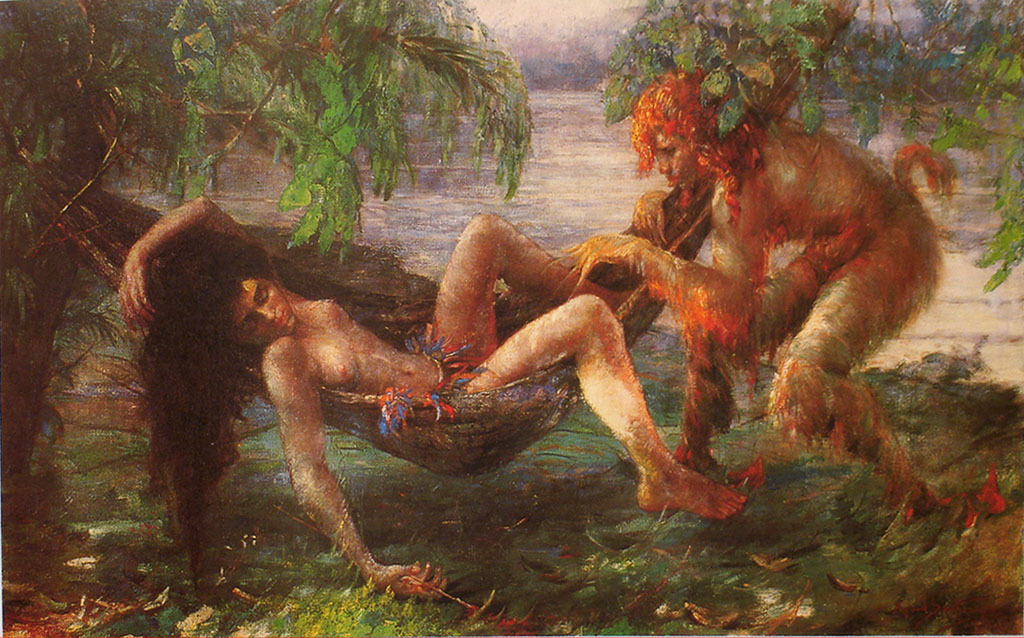 |
| Painting of A Curupiras |
A Curupira will prey on poachers and hunters that take more than they need of the forest, and he also attacks people that hunt animals that were taking care of their offspring. There are many different versions of the legend, and so the creature's appearance and habits may vary from each region in Brazil. However, Curupira is considered a nationwide folkloric figure.
Curinqueans:
 |
| Artists impression of Curinquean |
Despite this creature's ridiculous, biologically implausible size, plenty of documented tracks and eyewitness reports depict a Bigfoot of up to twenty feet tall, or perhaps even larger. Usually lean and lanky, it leaves footprints longer than twenty inches. This creature is heavily shrouded in folklore. The North American variety of true giant is often shown as related to or identical to the windigo (a cannibal giant that is sometimes also a shapeshifter) and the Curinqueans (a human shapeshifter whose only purpose is to fight the evil windigo).
Outside of America, there are other reports of hairy humanoids way bigger that most cryptozoologists would accept. To make the situation even worse, many of these creatures have characteristics associated more with folklore giants or ogres than with biological entities. Scotland's Big Gray Man is one example.
Ghana also has a legendary man-ape of extraordinary size, called the Tano giant. Louis Bowler described the creature in a 1911 book called Gold Coast Palaver as looking like a giant combination of ape and man, with arms as thick as a normal human's torso. The Tano giant is supposed to have pale skin, black fur, a monkey's head that is flat on top, and, like ogres worldwide, is blamed for devouring humans and carrying off women. The Tano giant fears fire, is reputed to be impervious to bullets, and sometimes carries a leather blanket. Some researchers think that the Tano giant is a mythologized version of the gorilla or is a new, undiscovered ape.
Another true giant is the Australian rexbeast, a variety of yowie said to leave 35-inch-long footprints. The rexbeast has been popularized in cryptozoology circles by Rex Gilroy, who says the creature also exists in Aboriginal folklore, yet he was strangely unable to find a native name for it. The rexbeast might be identical to another extra-large yowie, the quinkin of Queensland.
Reports of true giants from southeast Asia also sound much like fairy-tale ogres. The Nyalmo of Bangladesh reportedly can be 20 feet tall. This big hairy monster is associated with the yeti by some researchers, but it also has connections to werewolf-like monsters from Burma and Thailand. The Curinquean of Brazil and Paraguay is typical of South American orges. It is blamed for cattle mutilation deaths where the tongue has been removed but nothing else has been touched.
Di-di or Didi and Mono Grand:
NO IMAGES EXIST
The Mono Grande (Spanish for "Large Monkey"), a large monkey-like creature, has been occasionally reported in South America. Such creatures are reported as being much larger than the commonly accepted new world monkeys. These accounts have received rather little publicity, and typically generated little or no interest from mainstream experts, but have received some notice in Cryptozoology.Friday 21 June 2013
wildmen 3: The Wildmen of Austrialia.
Australia is home too two wild men, like the Canadian Sasquatch, these creatures share the same name, Yowie, a name that didn't appear before 1970. The original name was Youree or Yahoo meaning devil, devil-devil or evil/demonic spirit, The Aborigines that saw this creature passed the tales down the generations till the Yowie becomes almost as big a phenomena as the American Sasquatch.
The more Sasquatch-like Yowie is seen more than the man-like Yowie as it's believed that the man-like Yowie may be a remnant of the species Homo Neanderthalensis. The Yowie goes by many names in different parts of Australia in Southern Australia it is known as: Yoser, Tjangara, Yay-ho, Koyoreowen. In Western Australia: Jimbra, Jingera, Turramulli, and Lo-an.
While not much photographic evidence has surfaced for the man-like Yowie physical evidence has,
Physical evidence for a wildman is normally flesh or hair samples, but for the Man-like Yowie and a few other Wildmen around the world the physical evidence is tools.
Because Wildmen are split into two categorizes, Apemen and Hominids (Humans are part of this group). Apeman sightings are more common than Hominid sightings because it is believed that Homo Sapiens wiped out all other Hominid Species on the Earth, the last being Homo Neanderthalensis.
The Sasquatch-like Yowie is reported to be 10 feet tall and covered with thick hair (which varies from anything between orange to pure black. and is very violent towards humans. And its stare is supposed to be that of an intelligent creatures.
The Man-like Yowie is said to be 5-8 feet tall and wheres a thick fur coat. It's reported to be kinder towards humans but will attack if it feels threatened. both creatures avoid us as much as they possibly can.
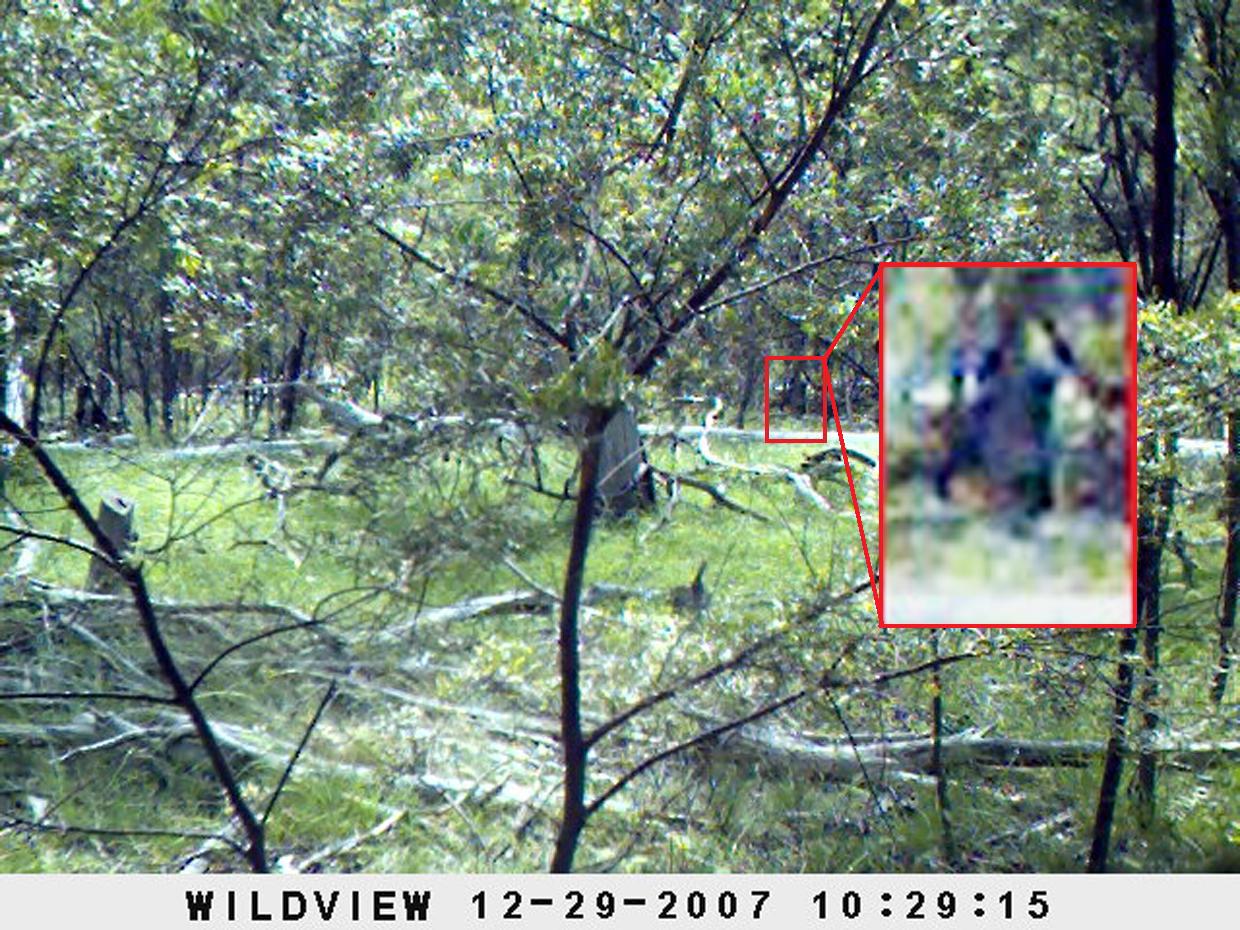 |
| The more Sasquatch like Yowie caught on camera, a rare find as the Yowie is a very elusive creature. |
While not much photographic evidence has surfaced for the man-like Yowie physical evidence has,
 |
| A spear supposedly made by the man-like Yowie, found in Australian woodland. |
Physical evidence for a wildman is normally flesh or hair samples, but for the Man-like Yowie and a few other Wildmen around the world the physical evidence is tools.
Because Wildmen are split into two categorizes, Apemen and Hominids (Humans are part of this group). Apeman sightings are more common than Hominid sightings because it is believed that Homo Sapiens wiped out all other Hominid Species on the Earth, the last being Homo Neanderthalensis.
 |
| Artists conception of Sasquatch-like Yowie |
The Sasquatch-like Yowie is reported to be 10 feet tall and covered with thick hair (which varies from anything between orange to pure black. and is very violent towards humans. And its stare is supposed to be that of an intelligent creatures.
 |
| Possible Yowie claw or bite marks. |
The Man-like Yowie is said to be 5-8 feet tall and wheres a thick fur coat. It's reported to be kinder towards humans but will attack if it feels threatened. both creatures avoid us as much as they possibly can.
 |
| Artists conception of man like Yowie. |
Thursday 20 June 2013
PREVIOUS OCCUPANTS OF EARTH and TIME TRAVEL EVIDENCE
The Earth holds many Secrets, most of them are yet to be discovered, but it has shown one of its darkest secrets...... we are NOT the first intelligent specie to evolve on this planet.
The DINOSAPIENS:
 | ||||||||||
| artists conception of a Dinosapien |
Its thought that the Dinosaurs were not wiped out by a giant meteorite that slammed into the gulf of Mexico with double the the power of the Hiroshima bomb.
However mysterious "Lizard men" have been seen in North America (mainly Florida) for years, these "Lizard men" are supposed to rip holes in cars.
Others claim that the Dinosapians are not only still alive but have worked their way into the highest forms of government.
THE PROOF:
A set of bipedal foots where found to be 65 million years old, yet they looked Humanoid or Hominid. the interesting thing is it that these foot prints where found to have claws on the end, these claws where shorter than that of say a Dromeasaur (The family that Velocoraptors belong too), this led to a popular belief of a sentient Reptilians specie, this is now a world wide phenomena.
TIME TRAVEL EVIDENCE: the following is a photo proving time travel exist.
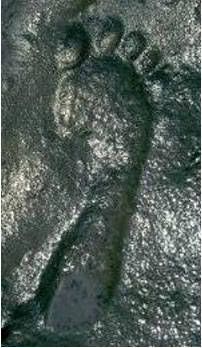 | ||||
| anciant foot print found to have | been made over a million years ago |
Subscribe to:
Posts (Atom)

